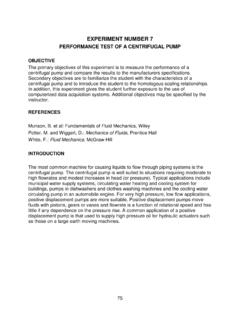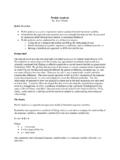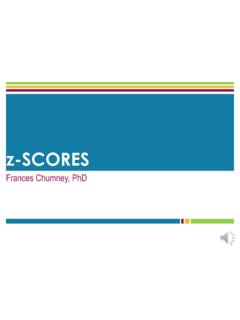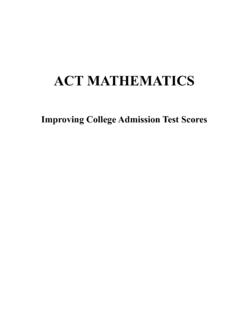Transcription of DISCRIMINANT FUNCTION ANALYSIS (DA)
1 DISCRIMINANT FUNCTION ANALYSIS (DA). John Poulsen and Aaron French Key words: assumptions, further reading, computations, standardized coefficents, structure matrix, tests of signficance Introduction DISCRIMINANT FUNCTION ANALYSIS is used to determine which continuous variables discriminate between two or more naturally occurring groups. For example, a researcher may want to investigate which variables discriminate between fruits eaten by (1) primates, (2) birds, or (3) squirrels. For that purpose, the researcher could collect data on numerous fruit characteristics of those species eaten by each of the animal groups. Most fruits will naturally fall into one of the three categories.
2 DISCRIMINANT ANALYSIS could then be used to determine which variables are the best predictors of whether a fruit will be eaten by birds, primates, or squirrels. Logistic regression answers the same questions as DISCRIMINANT ANALYSIS . It is often preferred to discriminate ANALYSIS as it is more flexible in its assumptions and types of data that can be analyzed. Logistic regression can handle both categorical and continuous variables, and the predictors do not have to be normally distributed, linearly related, or of equal variance within each group (Tabachnick and Fidell 1996). DISCRIMINANT FUNCTION ANALYSIS is multivariate ANALYSIS of variance (MANOVA).
3 Reversed. In MANOVA, the independent variables are the groups and the dependent variables are the predictors. In DA, the independent variables are the predictors and the dependent variables are the groups. As previously mentioned, DA is usually used to predict membership in naturally occurring groups. It answers the question: can a combination of variables be used to predict group membership? Usually, several variables are included in a study to see which ones contribute to the discrimination between groups. DISCRIMINANT FUNCTION ANALYSIS is broken into a 2-step process: (1) testing significance of a set of DISCRIMINANT functions, and; (2) classification.
4 The first step is computationally identical to MANOVA. There is a matrix of total variances and covariances; likewise, there is a matrix of pooled within-group variances and covariances. The two matrices are compared via multivariate F tests in order to determine whether or not there are any significant differences (with regard to all variables) between groups. One first performs the multivariate test, and, if statistically significant, proceeds to see which of the variables have significantly different means across the groups. Once group means are found to be statistically significant, classification of variables is undertaken.
5 DA automatically determines some optimal combination of variables so that the first FUNCTION provides the most overall discrimination between groups, the second provides second most, and so on. Moreover, the functions will be independent or orthogonal, that is, their contributions to the discrimination between groups will not overlap. The first FUNCTION picks up the most variation; the second FUNCTION picks up the greatest part of the unexplained variation, Computationally, a canonical correlation ANALYSIS is performed that will determine the successive functions and canonical roots. Classification is then possible from the canonical functions.
6 Subjects are classified in the groups in which they had the highest classification scores. The maximum number of DISCRIMINANT functions will be equal to the degrees of freedom, or the number of variables in the ANALYSIS , whichever is smaller. Standardized coefficients and the structure matrix DISCRIMINANT functions are interpreted by means of standardized coefficients and the structure matrix. Standardized beta coefficients are given for each variable in each DISCRIMINANT (canonical) FUNCTION , and the larger the standardized coefficient, the greater is the contribution of the respective variable to the discrimination between groups.
7 However, these coefficients do not tell us between which of the groups the respective functions discriminate. We can identify the nature of the discrimination for each DISCRIMINANT FUNCTION by looking at the means for the functions across groups. Group means are centroids. Differences in location of centroids show dimensions along which groups differ. We can, thus, visualize how the two functions discriminate between groups by plotting the individual scores for the two DISCRIMINANT functions. Another way to determine which variables define a particular DISCRIMINANT FUNCTION is to look at the factor structure. The factor structure coefficients are the correlations between the variables in the model and the DISCRIMINANT functions.
8 The DISCRIMINANT FUNCTION coefficients denote the unique contribution of each variable to the DISCRIMINANT FUNCTION , while the structure coefficients denote the simple correlations between the variables and the functions. Summary To summarize, when interpreting multiple DISCRIMINANT functions, which arise from analyses with more than two groups and more than one continuous variable, the different functions are first tested for statistical significance. If the functions are statistically significant, then the groups can be distinguished based on predictor variables. Standardized b coefficients for each variable are determined for each significant FUNCTION .
9 The larger the standardized b coefficient, the larger is the respective variable's unique contribution to the discrimination specified by the respective DISCRIMINANT FUNCTION . In order to identify which independent variables help cause the discrimination between dependent variables, one can also examine the factor structure matrix with the correlations between the variables and the DISCRIMINANT functions. Finally, the means for the significant DISCRIMINANT functions are examined in order to determine between which groups the respective functions seem to discriminate. (For more detail, see Computations below.). Assumptions: DISCRIMINANT FUNCTION ANALYSIS is computationally very similar to MANOVA, and all assumptions for MANOVA apply.
10 Sample size: Unequal sample sizes are acceptable. The sample size of the smallest group needs to exceed the number of predictor variables. As a rule of thumb , the smallest sample size should be at least 20 for a few (4 or 5). predictors. The maximum number of independent variables is n - 2, where n is the sample size. While this low sample size may work, it is not encouraged, and generally it is best to have 4 or 5 times as many observations and independent Normal distribution: It is assumed that the data (for the variables) represent a sample from a multivariate normal distribution. You can examine whether or not variables are normally distributed with histograms of frequency distributions.

















